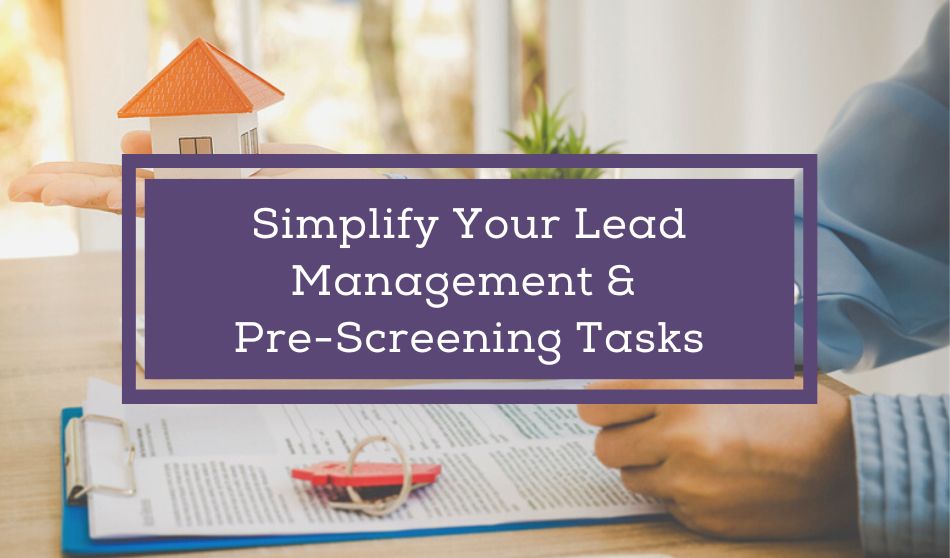
How you manage your prospective tenant leads, from interest to rental application, will help give you the best success to find the perfect tenant and fill vacancies. Getting too few or too many calls about vacancies? Check out this quick read for the 3 steps to getting the perfect quantity (and quality) of prospects for optimal occupancy.
What is the difference between a prospect and a lead?
Often in property management, the terms ‘lead’ and ‘prospect’ are used interchangeably. In general terms, a lead is an interested party but who hasn’t yet been pre-qualified. Whereas a prospect is a lead that has been preliminary qualified but typically has not yet submitted an application.
A lead might look like an email received, a voicemail, a call, or an online interest card sent regarding your vacancy or property. Once you’ve had a chance to interact with the lead to pre-qualify them, they would then be considered a prospect. After they submit an application they would then be referred to as a prospective tenant, or prospective renter or occupant.
What does ‘pre-qualified’ mean?
Pre-qualified is the term used to describe asking and answering questions to see if your lead would be a good fit for your rental criteria and your vacancy would be a good fit for their rental needs.
Step One: Capture interest to gain leads
When you have a vacancy, you want those ready to move to get their eyes on your listing and show interest before the competition scoops up the best prospects. And that comes down to marketing, publishing listings online, and syndication.
Marketing encompasses all the elements you add to your rental listing as well any and all information on and offline that tells the story of your business and what the tenant can expect.
Why is marketing important for gaining leads?
First, it helps those with specific criteria for their rental home to find your vacancy if it fits that need. Secondly, and conversely, it gives you the platform to outline your criteria. The better your marketing, the easier it will be to attract the best rental candidate; saving you valuable time.
Consider the features and amenities that make your property stand out in the rental market, and focus on those as you begin your marketing efforts. Does your property cater to pet owners? Is it close to public transportation or a city center? Does it have any unique features, particularly any that are uncommon for properties in that price range (think square footage, extra bathrooms, outdoor space)?
6 Insider Tips to Fill Rental Vacancies
Marketing Tip: Landlord software that tenants love will include easy setup of a customizable website for all your marketing needs. You might also consider outsourcing the web design to a company who understands the rental real estate market. Check with your property management software for recommendations and integrations with web design services for your custom website options.
Flyers and flags still work to attract leads but the best method to find the most candidates is to publish your vacancies online. If you’re just getting started as a landlord or only have one rental property, having a website and publishing your vacancy will give you credibility as well as opportunity to make a good first impression, set expectations, and create a better tenant-landlord relationship.
Syndication is a tool within property management software that will push your vacancy listing out to other websites to help get the word out to as many potential new tenants as possible. The larger the syndication network, the more websites your rental listing could populate; which equals more opportunities for it to be seen.
Your website, vacancy listings, and other marketing material done well, will help funnel out those that don’t meet your rental criteria and attract potential renters that are a match.
Step Two: Convert a lead into a prospect
In many cases, your property management software will have a lead management component where you can store information and manage the communication and notes for all interested parties at any stage of the pre-application process.
Whether you use a dedicated software component or some other tracking method, turning a lead into a prospect is all about the questions you ask. This will help you funnel out unsuitable applicants in advance.
You could conduct this pre-screening interview either in person, online video, or over the phone. Some landlords choose to make the pre-screening mandatory prior to accepting applications while other landlords use a pre-screening interview prior to processing the application or running a background check.
Why pre-screen prospects when I already do a complete background check on applicants?
Pre-screening is an important step because your time is valuable. Whether someone calls in, emails you questions, or comes by the office – asking and answering questions can not only give you a better pool of applicants to choose from but also reduce the number of vacancy rental showings to those not qualified or simply ‘window-shopping’.
Pre-screening questions to ask
Because you only want the most qualified potential tenants to submit applications, pre-screening questions are your go-to resource. The types of questions you could ask are:
- When are you looking to move?
- What caught your eye about this property?
- How long have you lived at your current residence?
- What makes you want to move at this time?
- How many people will be living with you in this property?
- Of those, do you or others smoke?
- What pets do you have?
- Do you have references from your employer and/or former landlord?
- Does your current landlord know you want to move?
- What kind of parking are you looking for (how many vehicles)?
- Does your (you and/or all potential occupants) meet the income requirements?
- Can you meet the move-in cost requirements?
Remember, there are some questions to never ask a prospective tenant no matter what stage of the process. The Fair Housing Act protects renters from discrimination based on race, nationality, religion, sex and sexual orientation, family status, and disability. In addition, some States have additional protected classes so be sure to stay informed on the regulations to ensure you aren’t unintentionally ask questions that could be considered discriminatory. Also check with your real estate board if your State allows you to ask questions about evictions due to the pandemic and be careful when asking questions regarding past felony charges.
Deep Dive: Should a Felony Charge Disqualify a Prospective Tenant?
Step Three: Lead nurturing and communication
Let’s say you manage a 100 unit apartment complex and are always getting calls asking about vacancies. If you have none, instead of having them check back with you at a later date, you could choose to collect information and ask pre-qualifying questions to create a waiting list. Then, the next time you receive a move-out notice you could already have qualified applicants at the ready and might not even need to publish your vacancy to get it filled.
The important step is to keep in communication with your leads. In that, be sure to ask your prospects if they would like to be on your early-bird email list to get the news when vacancies that meet their criteria become available.
Did you know? Some property management software programs allow you to publish information on all (or some) of your properties, and receive electronic interest cards from people looking at your properties? Those interest cards would then populate in the software for you to easily use to track and document all your communications and notes to these leads/prospects.
Deep Dive: The Easiest Tenant Lead Tracking Solution (That Actually Works!)
Next Steps | From prospect to renter
A good tenant-landlord relationship doesn’t start at lease signing or move-in day. It starts from the point of contact a lead has with you and your property; whether that’s a phone call, seeing your website, or rental listing online.
But it doesn’t stop there, your next steps are to show the rental property and be ready to:
- Process rental applications
- Conduct tenant screening
- Present a denial (adverse notices) or acceptance letter
- Customize a lease and prepare the tenant for the big day!
Lead tracking done with pre-screening and good marketing will cut down on the number of ‘only looking’ and unqualified prospects, unnecessary rental showings, and make filling those vacancies with the best tenants a breeze!





